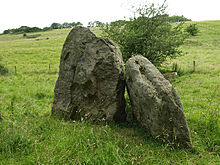|
|
|
|
CorscombeStanding Stones
|
||||||||||||||||||||||||
|
|
|
Images (click to view fullsize) |
|






|
Fieldnotes |
|
|
This is an intriguing site, which if it is genuinely megalithic would certainly add greatly to the small amount of stones in Dorset. The site itself falls into three groups in a valley bottom south of the village of Corscombe. The whole area of the stones is about 50 metres north / south by about 20 metres east / west. The southern are two recumbent stones laying next to each other, giving the appearance of having been toppled. These are the largest stones, one being 8 1/2 feet long, the other about 6 feet. The smaller of the two has a blackthorn tree growing around it's base. The three standing stones are to the north, the central and largest stone is 6 1/2 feet high and has a pointed top. The next in size leans against the other and has a broken lower corner. The smallest of the three is reputedly known as the "Devil's Seat" or "Granny's Armchair" and does resemble a chair. To the west of these are a group of six smaller stones laying in the grass in an arc. In amongst these and between them and the standing stones are smaller stones or fragments of larger, broken stones. This site has been variously described as a destroyed long barrow, a disrupted stone circle or just a random colection of stones at the bottom of a steep sided valley. Whatever the answer to this place is, someone has made an effort to lean two of the stones against each other, and the two southern stones have been there long enough for an elderly tree to have grown around one of them. Although not a scheduled ancient monument, english heritage does give it the monument number 195903. It may be pure coincidence but just to the north of the site is a road and track named barrow lane. If anyone knows any more about these stones I'd be very interested to know about them. |
 Posted by formicaant
Posted by formicaant15th July 2008ce Edited 22nd September 2022ce |
Miscellaneous |
|
|
Details of stones on Pastscape Boulders [NAT] [Three Shewn] (1) [ST 51370488] Standing Stones: Three stones 70 yds. S.S.W of Beckhams Coppice. They are set upright as though to form the end of a chamber. They measure 5' 9" high and 4' 6" wide, 3' 6" high and 5' wide, and 4' high and 2' 6" wide. 8 yards to the W. are two prone stones 5' long and another 50yds to the S.S.W. which measures 8' by 4'. The intervening space appears to have been disturbed. (2) 1/2 mile NW. of the Hoar Stones is a destroyed chambered long barrow consisting of 4 stones, locally known as The Devil's Arm Chair. [Probably applies.] (3) Whereas the three stones are erected as if to form a chamber they are particularly weathered and are rather flat. Their heights are 1.2m, 1.5m and 1.8m. The significant fact about the entire group is that they are situated on the floor of a steep sided valley. The ground between the group of three and the prostrate one to the south west has been dug out. The other prostrate stones are covered by bushes. There is evidence of light quarrying on the valley sides. These stones may be contemporary with the quarrying. (4) Perambulation revealed no traces of the alleged long barrow in the area stated. If the remark is intended to refer to these stones, the point is made that the site is topographically unsuitable, the orientation (NNE-SSW) is unusual, and the stones do not have the appearance of great age in their present situation. There seems little to warrant this site as an antiquity of any form. The legendary name "Devil's Arm Chair" was unknown to local people questioned. (5) These stones remain as described but they are not the remains of an archaeological feature or setting. (6) |
 Posted by Chance
Posted by Chance14th April 2016ce Edited 14th April 2016ce |

